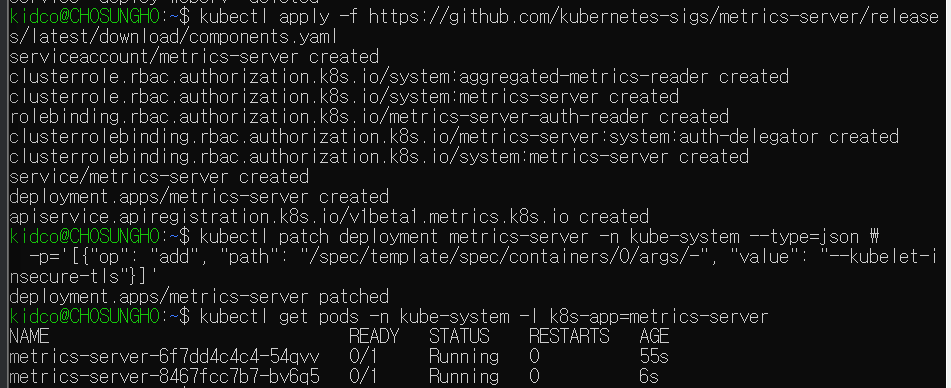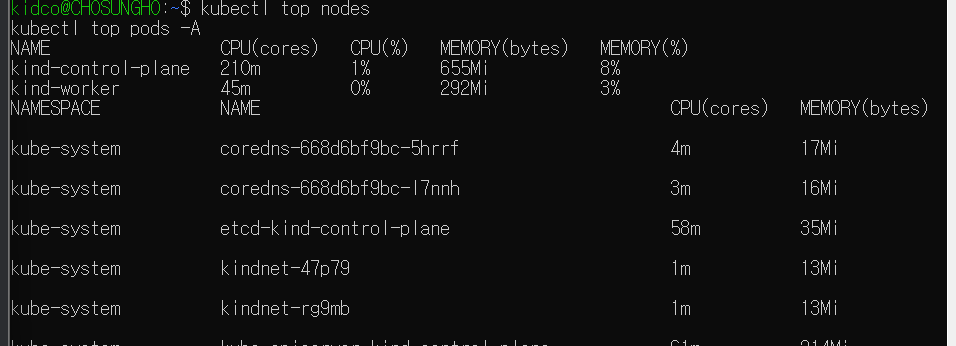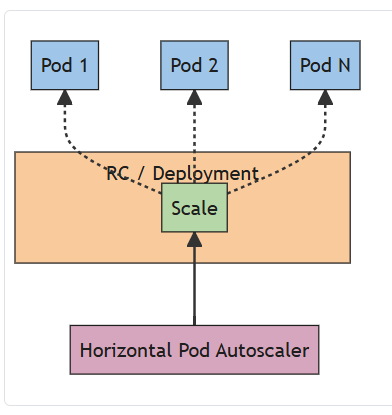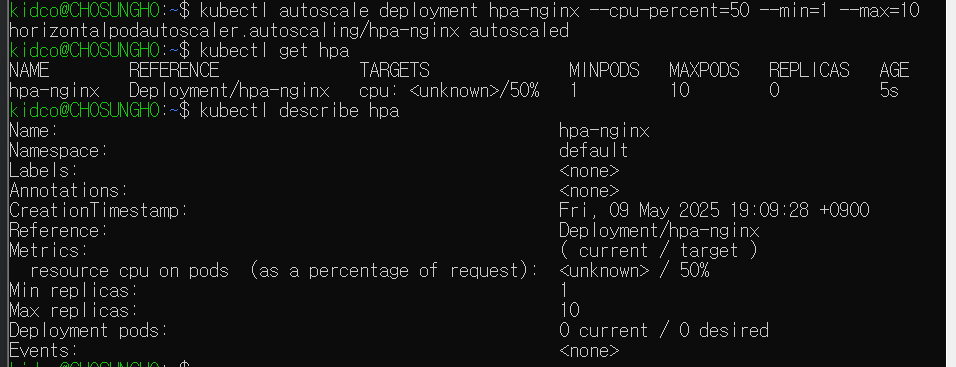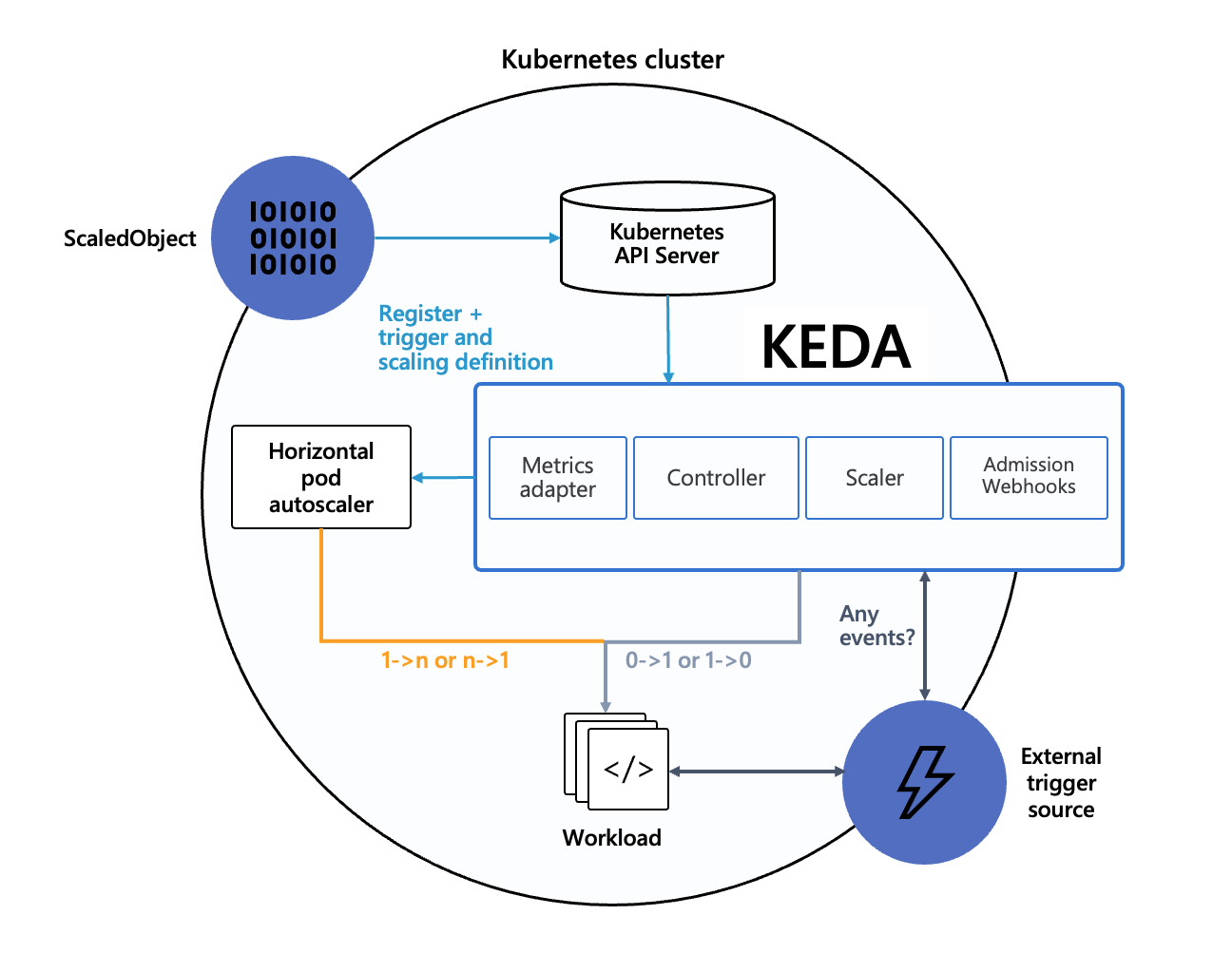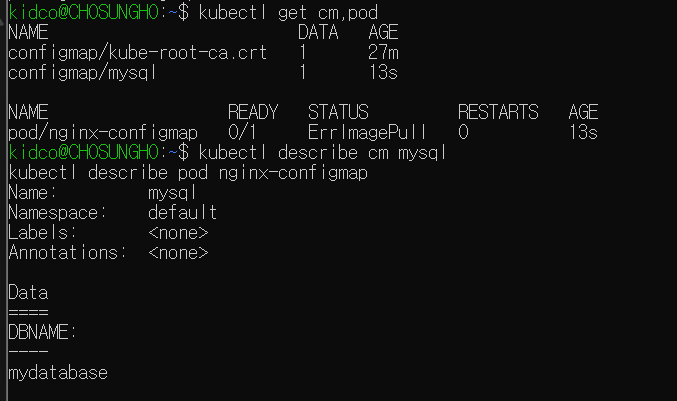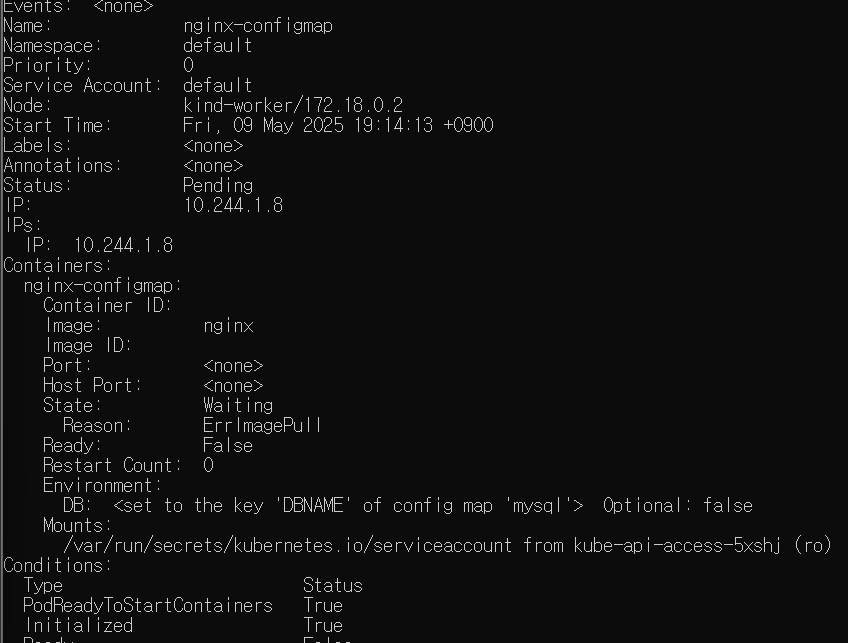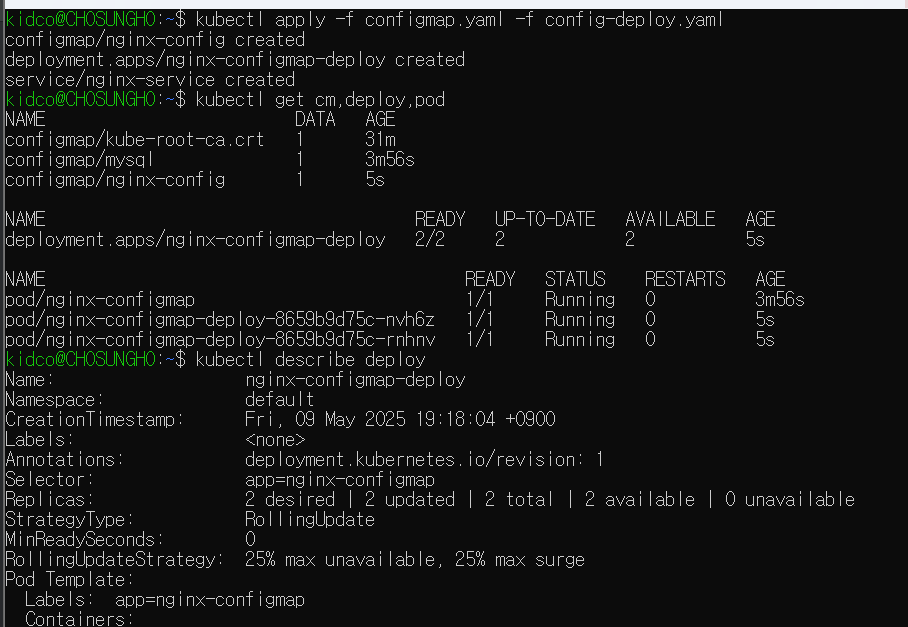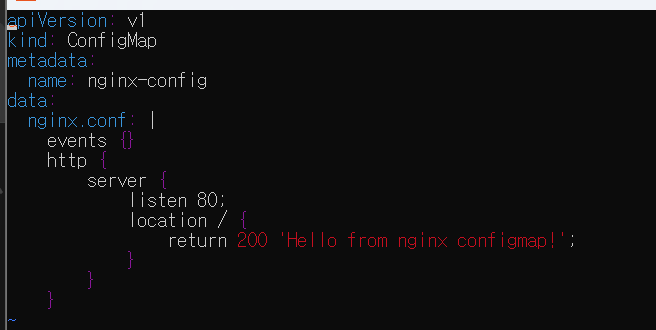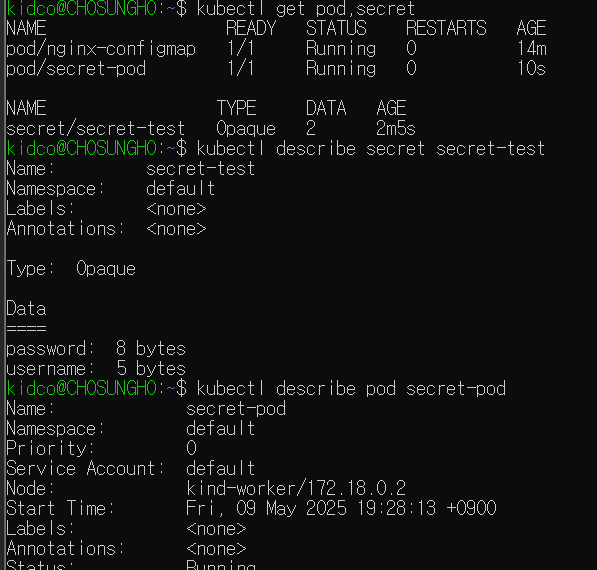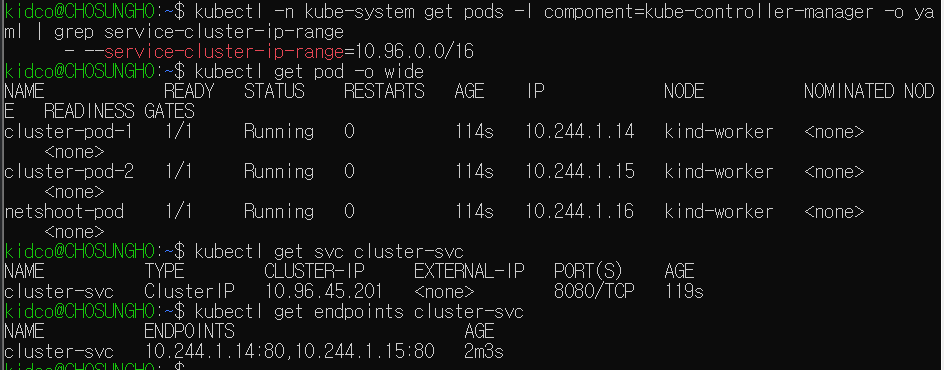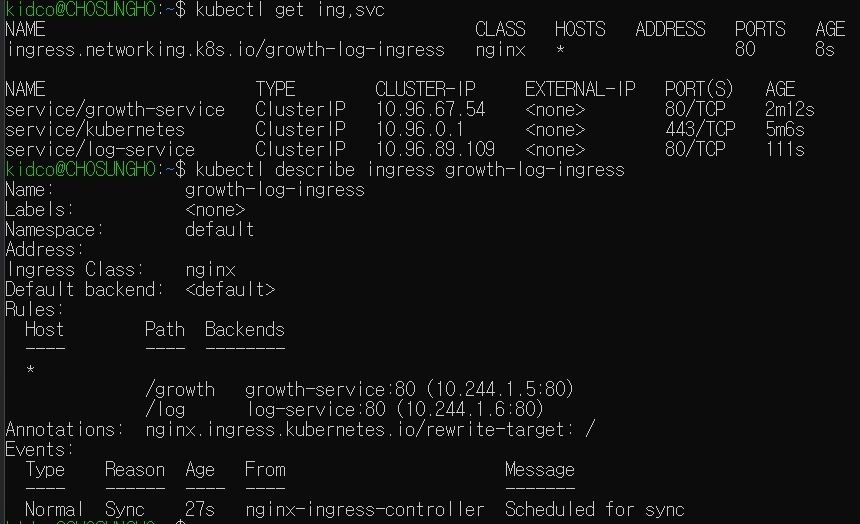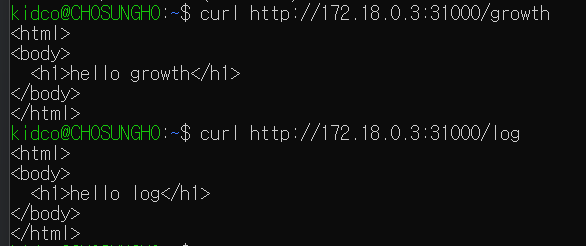3주차 - Kubernetes Availability & Network
🚢 쿠버네티스 가용성
쿠버네티스 가용성 확보를 위한 다양한 방법
쿠버네티스(Kubernetes) 환경에서는 서비스 가용성(Availability) 확보를 위해 다양한 자동 확장 기능을 제공
쿠버네티스 확장 방법
| 확장 방식 |
설명 |
| HPA (Horizontal Pod Autoscaler) |
Pod의 수를 수평으로 자동 조절 (Scale In/Out) |
| VPA (Vertical Pod Autoscaler) |
Pod의 리소스(CPU/Memory 등)를 수직으로 자동 조절 (Scale Up/Down) |
| CA (Cluster Autoscaler) |
노드를 자동으로 추가/제거 (Cloud 환경에서 활용) |
- 이러한 기능을 활용하면 트래픽 증가나 리소스 사용량 변화에 따라 자동으로 자원을 조절하여 시스템의 안정성과 가용성을 높일 수 있음
Metrics Server란?
Metrics Server는 쿠버네티스의 내장 확장 기능(HPA, VPA 등) 이 동작하는 데 필요한 리소스 사용량 정보를 수집하는 컴포넌트
- Kubelet에서 CPU, 메모리 등 지표를 수집하여 API Server에 전달
- HPA, VPA와 같은 오토스케일러가 이를 바탕으로 리소스 확장을 수행
- 모니터링 솔루션이 아닌, 확장을 위한 데이터 제공자
Metrics Server 설치 및 명령어
참고자료
1
2
3
4
5
6
7
8
9
|
# Metrics Server 설치
kubectl apply -f https://github.com/kubernetes-sigs/metrics-server/releases/latest/download/components.yaml
# Kubelet 인증서 검증 비활성화 (TLS 오류 방지)
kubectl patch deployment metrics-server -n kube-system --type=json \
-p='[{"op": "add", "path": "/spec/template/spec/containers/0/args/-", "value": "--kubelet-insecure-tls"}]'
# 설치 확인
kubectl get pods -n kube-system -l k8s-app=metrics-server
|
1
2
3
4
5
6
7
8
9
10
11
|
# 전체 노드의 리소스 사용량
kubectl top nodes
# 전체 네임스페이스의 Pod 사용량
kubectl top pods -A
# CPU 사용량 기준 정렬
kubectl top pods -A --sort-by=cpu
# 메모리 사용량 기준 정렬
kubectl top pods -A --sort-by=memory
|
HPA
출처: https://kubernetes.io/ko/docs/tasks/run-application/horizontal-pod-autoscale/
수평 스케일링 (HPA, Horizontal Pod Autoscaling)
- 부하 기반 자동 스케일링 기능
- Pod의 수를 자동으로 늘리거나 줄임(Scale Out/In)
- 기본적으로 CPU와 메모리 사용률, 사용자 정의 지표를 기준으로 작동
- 지표 수집은 Metrics Server를 통해 이뤄지며, 설정한 임계치(Threshold)를 초과하면 Replica 수를 조정함
-
작동 원리
- Metrics Server가 CPU, Memory 사용률을 수집
- HPA가 지정한 타겟 리소스(Deployment 등)의 부하를 모니터링
- 설정한 기준치를 초과하면 Pod 수를 자동으로 조절
- 기본 구성
1
2
3
4
5
6
7
8
9
10
11
12
13
14
15
16
17
18
19
20
21
22
23
24
|
apiVersion: autoscaling/v2
kind: HorizontalPodAutoscaler
metadata:
name: hpa-sample
spec:
scaleTargetRef: # Scale 타겟 지정
apiVersion: apps/v1
kind: Deployment
name: my-app # Deployment 이름
minReplicas: 2 # 최소 Pod
maxReplicas: 10 # 최대 Pod
metrics: # Scale 기준 지표 설정
- type: Resource
resource:
name: cpu
target:
type: Utilization
averageUtilization: 50 # CPU 사용률 50% 기준
- type: Resource
resource:
name: memory
target:
type: Utilization
averageUtilization: 70 # 메모리 사용률 70% 기준
|
HPA 구성
1
2
3
4
5
6
7
8
9
10
11
12
13
14
15
16
17
18
19
20
21
22
23
24
25
26
27
28
29
30
31
32
33
34
35
36
37
38
39
40
41
42
43
44
45
|
cat << EOF >> hpa-nginx.yaml
apiVersion: apps/v1
kind: Deployment
metadata:
name: hpa-nginx
spec:
replicas: 1
selector:
matchLabels:
app: hpa-nginx
template:
metadata:
labels:
app: hpa-nginx
spec:
containers:
- name: hpa-nginx
image: nginx
resources:
requests:
cpu: 50m
limits:
cpu: 100m
ports:
- containerPort: 80
---
apiVersion: v1
kind: Service
metadata:
name: hpa-nginx
labels:
app: hpa-nginx
spec:
ports:
- port: 80
selector:
app: hpa-nginx
EOF
cat hpa-nginx.yaml
# Deployment 배포
kubectl apply -f hpa-nginx.yaml
kubectl get deploy,pod
|
1
2
3
4
5
6
7
8
|
# HPA 생성
kubectl autoscale deployment hpa-nginx --cpu-percent=50 --min=1 --max=10
# HPA 확인
kubectl get hpa
# HPA 상세 정보 확인
kubectl describe hpa
|
1
2
3
4
5
6
7
8
9
10
11
12
13
14
15
16
17
18
|
apiVersion: autoscaling/v2
kind: HorizontalPodAutoscaler
metadata:
name: hpa-nginx
spec:
scaleTargetRef:
apiVersion: apps/v1
kind: Deployment
name: hpa-nginx
minReplicas: 1
maxReplicas: 10
metrics:
- type: Resource
resource:
name: cpu
target:
type: Utilization
averageUtilization: 50
|
1
2
3
4
5
6
7
8
9
|
# 터미널 1번
while true; do kubectl get hpa; kubectl top pods; sleep 1s; done
# 터미널 2번
kubectl run -i --tty load-generator --rm --image=busybox:1.28 --restart=Never -- /bin/sh -c "while true; do wget -q -O- http://hpa-nginx.default.svc.cluster.local; done"
# 실습 종료 후 리소스 삭제
kubectl delete hpa --all
kubectl delete -f hpa-nginx.yaml
|
VPA
출처: https://www.sktenterprise.com/bizInsight/blogDetail/dev/4488
수직 스케일링 (VPA, Vertical Pod Autoscaling)
- Pod 단위의 CPU, Memory 요청량을 자동으로 튜닝
- HPA는 수평 확장 / VPA는 수직 확장
-
조정 대상: CPU, Memory의
Request 값
-
VPA Recommender가 애플리케이션의 사용량을 분석하여 최적의 리소스를 적용
- HPA와 VPA는 하나의 Deployment에 동시에 적용 불가
-
Kubernetes v1.33부터 기본 활성화
- ⚠️ 현재
kind는 v1.32까지만 지원 → 별도 컨트롤러 설치 필요
- 기본 구성
1
2
3
4
5
6
7
8
9
10
11
12
13
14
15
16
17
18
19
20
|
apiVersion: autoscaling.k8s.io/v1
kind: VerticalPodAutoscaler
metadata:
name: my-app-vpa
spec:
targetRef: # Scale 대상
apiVersion: apps/v1
kind: Deployment
name: my-app # Deployment 명칭
updatePolicy:
updateMode: "Auto" # VPA Recommender 에 의해 자동 조정 활성화
resourcePolicy:
containerPolicies:
- containerName: my-app-container # Container 명칭 "*" 사용 가능
minAllowed: # 컨테이너가 할당받을 수 있는 최소 리소스
cpu: "200m"
memory: "512Mi"
maxAllowed: # 컨테이너가 할당받을 수 있는 최대 리소스
cpu: "2"
memory: "2Gi"
|
VPA 테스트
- 0.1 cpu 를 요청한 2개 Pod 배포 (실제 사용량보다 부족한 상태)
1
2
3
4
5
6
7
8
9
10
11
12
13
14
15
16
17
18
19
20
21
22
23
24
25
26
27
28
29
30
31
32
33
34
35
36
37
38
39
40
41
42
43
44
45
46
47
48
|
apiVersion: "autoscaling.k8s.io/v1"
kind: VerticalPodAutoscaler
metadata:
name: hamster-vpa
spec:
targetRef:
apiVersion: "apps/v1"
kind: Deployment
name: hamster
resourcePolicy:
containerPolicies:
- containerName: '*'
minAllowed:
cpu: 100m
memory: 50Mi
maxAllowed:
cpu: 1
memory: 500Mi
controlledResources: ["cpu", "memory"]
---
apiVersion: apps/v1
kind: Deployment
metadata:
name: hamster
spec:
selector:
matchLabels:
app: hamster
replicas: 2
template:
metadata:
labels:
app: hamster
spec:
securityContext:
runAsNonRoot: true
runAsUser: 65534 # nobody
containers:
- name: hamster
image: registry.k8s.io/ubuntu-slim:0.14
resources:
requests:
cpu: 100m
memory: 50Mi
command: ["/bin/sh"]
args:
- "-c"
- "while true; do timeout 0.5s yes >/dev/null; sleep 0.5s; done"
|
1
2
3
4
5
6
7
8
9
10
11
12
13
14
15
|
# 터미널 1번
while true;
do date "+%Y-%m-%d %H:%m:%S";
kubectl get pod -l app=hamster;
kubectl get vpa;
kubectl describe pod | grep "Requests:" -A2;
echo "==============";
sleep 5s;
done
# 터미널 2번 (log 확인 용)
kubectl apply -f examples/hamster.yaml
# 자원 삭제
kubectl delete -f examples/hamster.yaml
|
CA, KEDA
쿠버네티스 환경에서는 애플리케이션의 부하가 증가하면 Pod 수뿐만 아니라, Pod를 배치할 노드(Node) 리소스도 부족해질 수 있다.
이럴 때 사용되는 도구가 바로 Cluster Autoscaler (CA) 와 Karpenter 이다.
📦 Cluster Autoscaler (CA)
공식 문서 보기
- 쿠버네티스 클러스터의 노드 수를 자동으로 조절하는 컴포넌트
- Pod의 요청 리소스를 만족시킬 수 있는 노드가 없으면 → 노드 자동 추가
- 일정 시간 동안 유휴 상태인 노드가 있으면 → 노드 자동 삭제
-
클라우드 환경에서 주로 사용 (AWS, GCP, Azure 등 지원)
-
Pod 단위로 동작하는 HPA, VPA와 달리, 노드 단위에서 작동
🚀 Karpenter
공식 사이트
- AWS에서 만든 노드 자동 조절 도구
- CA와 동일하게 노드를 자동 생성/삭제
-
노드 크기(사양)까지 자동 조절 → HPA + VPA + CA 기능 통합
- 더 빠른 노드 프로비저닝(생성) 가능
-
CA의 대체 도구로 각광받고 있음
✅ 정리
| 항목 |
Cluster Autoscaler (CA) |
Karpenter |
| 대상 |
노드 수 자동 조절 |
노드 수 + 노드 사양 자동 조절 |
| 주요 기능 |
유휴 노드 축소, 부족 시 확장 |
적절한 사양과 수의 노드 자동 생성 |
| 속도 |
상대적으로 느림 |
빠름 |
| 운영 환경 |
다양한 클라우드 |
AWS 중심 |
| 배포 복잡도 |
비교적 단순 |
다소 복잡하지만 자동화 강점 |
⚡ 이벤트 기반 오토스케일링 - KEDA
출처: https://keda.sh/docs/2.17/concepts/
KEDA 공식 사이트
- 이벤트 기반 자동 확장 도구
- HPA와 연동하여 이벤트 기반으로 Pod 수를 자동으로 조절
- CPU/Memory 외에도 Kafka, RabbitMQ, Azure Queue, Prometheus, Cron 등 다양한 이벤트 기반 확장 가능
🔧 어플리케이션 변수 관리
ConfigMap
출처: https://foxutech.medium.com/about-configmap-in-kubernetes-b6b9c0918ac2
- Kubernetes 애플리케이션의 구성 파일이나 환경 설정을 Key-Value 형태로 저장하고 관리
- 설정 값을 컨테이너 내부 환경 변수나 파일 형태로 주입 가능
-
애플리케이션 코드를 재빌드하지 않고 설정만 변경할 수 있음
💡 주요 사용 용도
| 항목 |
설명 |
| 설정 정보 분리 |
소스 코드와 분리된 외부 설정 파일 관리 |
| 환경별 구성 |
DEV / STG / PRD 등 환경에 따른 설정 값 분리 |
| 동적 구성 |
Pod 재배포 없이 구성 값 수정 가능 |
기본 구성
1
2
3
4
5
6
7
8
|
# ConfigMap 샘플 구성
apiVersion: v1
kind: ConfigMap
metadata:
name: my-config # ConfigMap 명칭
data:
key1: value1 # Key : Value 형태 값 주입
key2: value2
|
1
2
3
4
5
6
7
8
9
10
11
12
13
14
15
|
# ConfigMap 사용 예시
apiVersion: v1
kind: Pod
metadata:
name: my-app
spec:
containers:
- name: my-container
image: my-image
env:
- name: MY_CONFIG_KEY # 컨테이너에서 사용할 변수 Key 값
valueFrom:
configMapKeyRef:
name: my-config # 사용할 ConfigMap의 이름
key: key1 # ConfigMap 내의 키 -> 값: value1
|
기본활용
1
2
3
4
5
6
7
8
9
10
11
12
13
14
15
16
17
18
19
20
21
22
23
24
25
26
27
28
29
30
31
32
33
34
35
36
37
38
39
40
|
cat <<EOF | kubectl apply -f -
apiVersion: v1
kind: ConfigMap
metadata:
name: mysql
data:
DBNAME: mydatabase
---
apiVersion: v1
kind: Pod
metadata:
name: nginx-configmap
spec:
containers:
- image: nginx
name: nginx-configmap
env:
- name: DB
valueFrom:
configMapKeyRef:
name: mysql
key: DBNAME
EOF
# 오브젝트 확인
kubectl get cm,pod
# 상세 정보 조회
kubectl describe cm mysql
kubectl describe pod nginx-configmap
# pod 내부 변수 확인
kubectl exec -it nginx-configmap -- /bin/bash -c env
...
DB=mydatabase
...
# 리소스 삭제
kubectl delete pod --all
kubectl delete cm nginx-configmap
|
ConfigMap 으로 설정 파일 관리
1
2
3
4
5
6
7
8
9
10
11
12
13
14
15
16
17
18
19
20
21
22
23
24
25
26
27
28
29
30
31
32
33
34
35
36
37
38
39
40
41
42
43
44
|
# 테스트 파일 생성
cat << EOF >> config-deploy.yaml
apiVersion: apps/v1
kind: Deployment
metadata:
name: nginx-configmap-deploy
spec:
replicas: 2
selector:
matchLabels:
app: nginx-configmap
template:
metadata:
labels:
app: nginx-configmap
spec:
containers:
- name: nginx
image: nginx
ports:
- containerPort: 80
volumeMounts:
- name: config-volume
mountPath: /etc/nginx/nginx.conf
subPath: nginx.conf
volumes:
- name: config-volume
configMap:
name: nginx-config
---
apiVersion: v1
kind: Service
metadata:
name: nginx-service
spec:
selector:
app: nginx-configmap
ports:
- protocol: TCP
port: 80
targetPort: 80
nodePort: 31001
type: NodePort
EOF
|
1
2
3
4
5
6
7
8
9
10
11
12
13
14
15
16
17
|
cat << EOF >> configmap.yaml
apiVersion: v1
kind: ConfigMap
metadata:
name: nginx-config
data:
nginx.conf: |
events {}
http {
server {
listen 80;
location / {
return 200 'Hello from nginx configmap!';
}
}
}
EOF
|
리소스 배포
1
2
3
4
5
6
7
8
9
10
11
12
13
14
15
16
17
18
19
20
21
|
# ConfigMap + Deployment 적용
kubectl apply -f configmap.yaml -f config-deploy.yaml # ConfigMap과 Deployment 배포
# 리소스 확인
kubectl get cm,deploy,pod # 생성된 리소스 목록 확인
kubectl describe deploy # Deployment 상세 정보 확인
# -> ConfigMap이 어떻게 마운트되었는지 확인 가능
# Nginx 접속
open http://localhost:31001 # NodePort로 Nginx 접속
# ConfigMap 수정
vim configmap.yaml # 설정 파일 수정
# 예: return 200 'Modify from nginx configmap!';
# 변경 사항 적용
kubectl apply -f configmap.yaml # 변경된 ConfigMap 적용
kubectl rollout restart deploy nginx-configmap-deploy # Deployment 재시작으로 ConfigMap 반영
# 리소스 정리
kubectl delete -f configmap.yaml -f config-deploy.yaml # 리소스 삭제
|
🔐 Secret – Kubernetes 민감 정보 관리
Secret은 Kubernetes에서 비밀번호, 토큰, API 키 등 민감 정보를 안전하게 관리하기 위한 리소스이고,
ConfigMap과 유사하지만 Base64 인코딩된 형태로 값을 저장한다.
📌 Base64는 암호화가 아닌 인코딩입니다. 디코딩이 쉬우므로 별도의 보안 설정이 필요하다.
✅ 주요 특징
- 민감 정보 저장 (비밀번호, 토큰 등)
- Base64 인코딩 필수 (평문 저장 불가)
- 환경 변수나 파일로 Pod에 주입 가능
-
etcd 저장소에 저장되므로 암호화 및 접근 제어 권장
기본 구성
1
2
3
4
5
6
7
8
9
|
# Secret 샘플
apiVersion: v1
kind: Secret
metadata:
name: my-secret
type: Opaque
data:
username: bXl1c2Vy # base64로 인코딩된 값
password: bXlwYXNzd29yZA== # base64로 인코딩된 값
|
1
2
3
4
5
6
7
8
9
10
11
12
13
14
15
16
17
18
19
20
21
22
23
24
25
26
27
28
29
30
|
# Secret 사용 예시
apiVersion: v1
kind: Pod
metadata:
name: my-app
spec:
containers:
- name: my-container
image: my-image
env:
- name: DB_USER # Container 에서 사용할 변수명
valueFrom:
secretKeyRef:
name: my-secret # 사용할 Secret의 이름
key: username # Secret 내의 키
- name: DB_PASSWORD
valueFrom:
secretKeyRef:
name: my-secret # 사용할 Secret의 이름
key: password # Secret 내의 키
...
# 마운트 방법
volumeMounts:
- name: secret-volume # Volume 명칭
mountPath: /etc/secrets # 컨테이너 내부 마운트 위치
volumes:
- name: secret-volume # Volume 명칭
secret:
secretName: my-secret # 사용할 Secret의 이름
|
기본 활용
1
2
3
4
5
6
7
8
9
10
11
12
13
|
cat <<EOF | kubectl apply -f -
apiVersion: v1
kind: Secret
metadata:
name: secret-test
type: Opaque
data:
username: YWRtaW4= # 'admin'을 base64 인코딩한 값
password: cGFzc3dvcmQ= # 'password'를 base64 인코딩한 값
EOF
# Base64 인코딩 방법
echo -n 'admin' | base64
echo -n 'password' | base64
|
1
2
3
4
5
6
7
8
9
10
11
12
13
14
15
16
17
18
19
20
21
22
23
24
25
26
27
28
29
30
31
32
33
34
35
36
37
38
39
40
41
|
cat <<EOF | kubectl apply -f -
apiVersion: v1
kind: Pod
metadata:
name: secret-pod
spec:
containers:
- name: nginx
image: nginx
env:
- name: DB_USER
valueFrom:
secretKeyRef:
name: secret-test
key: username
- name: DB_PASS
valueFrom:
secretKeyRef:
name: secret-test
key: password
EOF
# Pod 및 Secret 확인
kubectl get pod,secret
# Secret 상세 정보 확인
kubectl describe secret secret-test
# Pod 상세 정보 확인
kubectl describe pod secret-pod
# pod 내부 변수 확인
kubectl exec -it secret-pod -- /bin/bash -c env
...
DB_USER=admin
DB_PASS=password
...
# 리소스 삭제
kubectl delete pod --all # 모든 Pod 삭제
kubectl delete secret secret-test # Secret 삭제
|
Secret 을 관리하는 다양한 도구
🟡 1. AWS Secrets Store CSI Driver (ASCP)
- AWS Secrets Manager 또는 Parameter Store의 값을 Kubernetes Secret처럼 사용 가능
- CSI(컨테이너 스토리지 인터페이스)를 통해 Pod에 자동 주입
- 자동 rotation, 권한 제어 등 AWS IAM과의 연동 강점
🔗 공식 문서 보기
🟣 2. HashiCorp Vault
- 강력한 비밀 관리 솔루션
- 암호화된 데이터 저장, 동적 비밀번호 발급, 정책 기반 접근 제어 지원
- Kubernetes와 연동하여 토큰을 통한 인증 및 자동 주입 가능
🔗 공식 문서 보기
🟢 3. Sealed Secrets
- Bitnami에서 제공하는 오픈소스 도구
- GitOps 환경에 최적화 (Git에 안전하게 저장 가능)
- SealedSecret → Secret 으로 컨트롤러가 복호화하여 자동 생성
- 공개키로 암호화, 클러스터 전용 비밀 키로 복호화
🔗 공식 문서 보기
🌐 Kubernetes 네트워크
출처: https://kubernetes.io/docs/concepts/cluster-administration/networking/
🔧 서비스 종류
service
- Kubernetes에서 단일 엔드포인트를 제공하는 리소스
- 파드(Pod) 집합을 하나의 네트워크 주소로 묶어 외부 혹은 내부 트래픽을 전달
- 공식 문서 바로가기 🔗
🟢 ClusterIP (기본값)
-
클러스터 내부 전용 가상 IP 제공
- 외부에서는 접근 불가
- 주로 마이크로서비스 간 통신에 사용
🔗 자세히 보기
🟠 NodePort
- 각 노드(Host)의 고정 포트를 통해 외부 접근 허용
- 외부에서는
NodeIP:Port 방식으로 접근 가능
- 간단한 테스트나 소규모 서비스 배포에 활용
🔗 자세히 보기
🔵 LoadBalancer
- 클라우드 환경에서 외부 로드 밸런서 자동 할당
- 서비스 엔드포인트에 퍼블릭 IP 부여
- AWS, GCP, Azure 등에서 사용 가능
🔗 자세히 보기
🧪 ClusterIP
테스트 환경 배포
1
2
3
4
5
6
7
8
9
10
11
12
13
14
15
16
17
18
19
20
21
22
23
24
25
26
27
28
29
30
31
32
33
34
35
36
37
38
39
40
41
42
43
44
45
46
47
48
49
50
51
52
53
54
55
56
57
|
# 어플리케이션 배포
cat << EOF >> cluster-pod.yaml
apiVersion: v1
kind: Pod
metadata:
name: cluster-pod-1
labels:
app: cluster-pod
spec:
containers:
- name: container
image: traefik/whoami
---
apiVersion: v1
kind: Pod
metadata:
name: cluster-pod-2
labels:
app: cluster-pod
spec:
containers:
- name: container
image: traefik/whoami
EOF
# Test 파드
cat << EOF >> netshoot-pod.yaml
apiVersion: v1
kind: Pod
metadata:
name: netshoot-pod
spec:
containers:
- name: netshoot-pod
image: nicolaka/netshoot
command: ["tail"]
args: ["-f", "/dev/null"]
EOF
# ClusterIP 서비스 생성
cat <<EOF>> cluster-svc.yaml
apiVersion: v1
kind: Service
metadata:
name: cluster-svc
spec:
type: ClusterIP
selector:
app: cluster-pod
ports:
- name: cluster
port: 8080
targetPort: 80
EOF
# 배포
kubectl apply -f cluster-pod.yaml -f cluster-svc.yaml -f netshoot-pod.yaml
|
Pod 생성 확인
1
2
3
4
5
6
7
8
9
10
11
12
13
14
15
16
17
18
19
20
21
22
23
24
25
26
27
28
29
30
31
32
33
34
|
# 파드 대역 확인
kubectl get nodes -o jsonpath='{.items[*].spec.podCIDR}'
...
10.244.0.0/24 10.244.1.0/24
...
# SVC 대역 확인
kubectl -n kube-system get pods -l component=kube-controller-manager -o yaml | grep service-cluster-ip-range
...
--service-cluster-ip-range=10.96.0.0/16
...
# 확인
kubectl get pod -o wide
...
NAME READY STATUS RESTARTS AGE IP NODE NOMINATED NODE READINESS GATES
cluster-pod-1 1/1 Running 0 8m20s 10.244.1.66 kind-worker <none> <none>
cluster-pod-2 1/1 Running 0 8m20s 10.244.1.65 kind-worker <none> <none>
netshoot-pod 1/1 Running 0 8m20s 10.244.1.67 kind-worker <none> <none>
...
# 서비스 확인
kubectl get svc cluster-svc
...
NAME TYPE CLUSTER-IP EXTERNAL-IP PORT(S) AGE
cluster-svc ClusterIP 10.96.138.114 <none> 8080/TCP 9m18s
...
# Endpoint 확인 (Pod IP:Port)
kubectl get endpoints cluster-svc
...
NAME ENDPOINTS AGE
cluster-svc 10.244.1.65:80,10.244.1.66:80 9m37s
...
|
ClusterIP 확인 (랜덤 트래픽 분산)
1
2
3
4
5
6
7
8
9
10
11
12
13
14
15
|
# 클라이언트(TestPod) Shell 실행
kubectl exec -it netshoot-pod -- zsh
# 서비스 ClusterIP 주입
SVC=10.96.138.114
curl $SVC:8080
curl -s $SVC:8080 | grep Hostname
# 100 번 반복 호출
for i in {1..100}; do curl -s $SVC:8080 | grep Hostname; done | sort | uniq -c | sort -nr
...
55 Hostname: cluster-pod-1
45 Hostname: cluster-pod-2
...
|
🌐 NodePort
테스트 환경 배포
1
2
3
4
5
6
7
8
9
10
11
12
13
14
15
16
17
18
19
20
21
22
23
24
25
26
27
28
29
30
31
32
33
34
35
36
37
|
# 어플리케이션 배포
cat << EOF > nodeport-pod.yaml
apiVersion: apps/v1
kind: Deployment
metadata:
name: nodeport-deploy
spec:
replicas: 2
selector:
matchLabels:
app: nodeport-deploy
template:
metadata:
labels:
app: nodeport-deploy
spec:
containers:
- name: container
image: traefik/whoami
EOF
# ClusterIP 서비스 생성
cat <<EOF> nodeport-svc.yaml
apiVersion: v1
kind: Service
metadata:
name: nodeport-svc
spec:
type: NodePort
selector:
app: nodeport-deploy
ports:
- name: nodeport-svc
port: 80 # 서비스 포트 (Cluster 내부에서 사용)
targetPort: 80 # 실제 컨테이너 포트
nodePort: 31001 # 외부에서 접근할 NodePort
EOF
|
생성 및 확인
1
2
3
4
5
6
7
8
9
10
11
12
13
14
|
# 생성
kubectl apply -f nodeport-pod.yaml -f nodeport-svc.yaml
# 확인
kubectl get pod,svc
...
NAME TYPE CLUSTER-IP EXTERNAL-IP PORT(S) AGE
service/nodeport-svc NodePort 10.96.66.182 <none> 80:31001/TCP 100s
...
# 연결된 IP:Port 목록 조회
kubectl get endpoints nodeport-svc
NAME ENDPOINTS AGE
nodeport-svc 10.244.1.10:80,10.244.1.11:80 2m50s
|
NodePort 동작 확인
1
2
3
4
5
6
7
8
9
10
|
# 노드의 Port 로 curl 요청
curl http://localhost:31001
curl -s http://localhost:31001 | grep Hostname
# 100 번 반복 호출
for i in {1..100}; do curl -s http://localhost:31001 | grep Hostname; done | sort | uniq -c | sort -nr
...
58 Hostname: nodeport-deploy-59b68567d7-6h562
42 Hostname: nodeport-deploy-59b68567d7-k2cpb
...
|
🚪 Ingress
출처: https://outshift.cisco.com/blog/k8s-ingress
참고문서
Ingress 리소스의 주요 특징
- 클러스터 외부에서 내부 서비스로 HTTP/HTTPS 트래픽을 전달
- 서비스 유형 (ClusterIP, NodePort, LoadBalancer)을 외부에 노출
- Ingress를 사용하려면 반드시 Ingress Controller가 필요
대표적인 Ingress Controller
- Nginx Ingress Controller (가장 널리 사용됨)
- 클라우드 제공 Ingress Controller
- AWS: ALB Ingress Controller
- GCP: GCE Ingress Controller
주요 기능
1.호스트 기반 라우팅
- 도메인에 따라 트래픽을 분기
- 예:
-
api.example.com → 서비스 A
-
www.example.com → 서비스 B
2.경로 기반 라우팅
- 요청 경로(URL)에 따라 트래픽을 분기
- 예:
-
/growth → 서비스 A
-
/log → 서비스 B
3.TLS 지원
4.로드 밸런싱
기본 구성
1
2
3
4
5
6
7
8
9
10
11
12
13
14
15
16
17
18
19
20
21
22
23
24
|
apiVersion: networking.k8s.io/v1
kind: Ingress
metadata:
name: example-ingress
namespace: default
spec:
rules:
- host: example.com # Domain Host
http:
paths:
- path: /service1 # URL Path (example.com/service1)
pathType: Prefix
backend:
service:
name: service1 # /service1 로 들어온 트래픽을 전송할 service 명
port:
number: 80
- path: /service2 # URL Path (example.com/service2)
pathType: Prefix
backend:
service:
name: service2
port:
number: 80 # /service2 로 들어온 트래픽을 전송할 service 명
|
Nginx Ingress Controller 설치
1
2
3
4
5
6
7
8
9
10
11
12
13
14
15
|
# 기존 리소스 삭제
kind delete cluster
# kind cluster 재배포
kind create cluster --config kind-2node.yaml
# Nginx Ingress Controller 설치
kubectl apply -f https://raw.githubusercontent.com/kubernetes/ingress-nginx/main/deploy/static/provider/cloud/deploy.yaml
# Service 타입 변경
kubectl patch svc ingress-nginx-controller -n ingress-nginx -p \
'{"spec":{"type":"NodePort","ports":[{"port":80,"targetPort":80,"nodePort":31000},{"port":443,"targetPort":443,"nodePort":31001}]}}'
# Nginx Ingress Controller 리소스 확인
kubectl get -n ingress-nginx svc,deploy,pod
|
서비스 생성
1
2
3
4
5
6
7
8
9
10
11
12
13
14
15
16
17
18
19
20
21
22
23
24
25
26
27
28
29
30
31
32
33
34
35
36
37
38
39
40
41
42
43
44
45
46
47
48
49
50
51
52
53
54
55
|
# Growth 서비스
cat << EOF > svc-growth.yaml
apiVersion: v1
kind: Service
metadata:
name: growth-service
spec:
selector:
app: growth
ports:
- protocol: TCP
port: 80
targetPort: 80
---
apiVersion: apps/v1
kind: Deployment
metadata:
name: growth-deployment
spec:
replicas: 1
selector:
matchLabels:
app: growth
template:
metadata:
labels:
app: growth
spec:
containers:
- name: nginx
image: nginx
ports:
- containerPort: 80
volumeMounts:
- name: growth-html
mountPath: /usr/share/nginx/html
volumes:
- name: growth-html
configMap:
name: growth-html
---
apiVersion: v1
kind: ConfigMap
metadata:
name: growth-html
data:
index.html: |
<html>
<body>
<h1>hello growth</h1>
</body>
</html>
EOF
kubectl apply -f svc-growth.yaml
|
1
2
3
4
5
6
7
8
9
10
11
12
13
14
15
16
17
18
19
20
21
22
23
24
25
26
27
28
29
30
31
32
33
34
35
36
37
38
39
40
41
42
43
44
45
46
47
48
49
50
51
52
53
54
55
56
|
# Log 서비스
cat << EOF > svc-log.yaml
apiVersion: v1
kind: Service
metadata:
name: log-service
spec:
selector:
app: log
ports:
- protocol: TCP
port: 80
targetPort: 80
---
apiVersion: apps/v1
kind: Deployment
metadata:
name: log-deployment
spec:
replicas: 1
selector:
matchLabels:
app: log
template:
metadata:
labels:
app: log
spec:
containers:
- name: nginx
image: nginx
ports:
- containerPort: 80
volumeMounts:
- name: log-html
mountPath: /usr/share/nginx/html
volumes:
- name: log-html
configMap:
name: log-html
---
apiVersion: v1
kind: ConfigMap
metadata:
name: log-html
data:
index.html: |
<html>
<body>
<h1>hello log</h1>
</body>
</html>
EOF
kubectl apply -f svc-log.yaml
|
1
2
3
4
5
6
|
# 배포 확인
kubectl get pod,svc,cm
# ConfigMap 확인
kubectl describe cm growth-html
kubectl describe cm log-html
|
Ingress 배포
1
2
3
4
5
6
7
8
9
10
11
12
13
14
15
16
17
18
19
20
21
22
23
24
25
26
27
28
29
|
cat << EOF > ingress-sample.yaml
apiVersion: networking.k8s.io/v1
kind: Ingress
metadata:
name: growth-log-ingress
annotations:
nginx.ingress.kubernetes.io/rewrite-target: / # /growth, /log 요청을 서비스로 전달할 때 접두사 제거. ex) /growth -> growth-service '/'
spec:
ingressClassName: nginx
rules:
- http:
paths:
- path: /growth
pathType: Prefix
backend:
service:
name: growth-service
port:
number: 80
- path: /log
pathType: Prefix
backend:
service:
name: log-service
port:
number: 80
EOF
kubectl apply -f ingress-sample.yaml
|
1
2
3
4
5
|
# 조회
kubectl get ing,svc
# 상세 정보 조회
kubectl describe ingress growth-log-ingress
|
Ingress 동작 확인
1
2
3
4
5
6
7
8
9
10
11
12
13
14
15
16
17
18
19
|
# growth 경로 호출
curl http://localhost:31000/growth
...
<html>
<body>
<h1>hello growth</h1>
</body>
</html>
...
# Log 경로 호출
curl http://localhost:31000/log
...
<html>
<body>
<h1>hello log</h1>
</body>
</html>
...
|
🧑💻 Kubernetes Storage
출처: https://kubetm.github.io/k8s/03-beginner-basic-resource/volume/
공식문서
📦 emptyDir
-
Pod 내부에서 컨테이너 간 공유되는 임시 스토리지
-
Pod 삭제 시 해당 스토리지도 함께 삭제
🖥️ hostPath
-
Worker Node의 Directory Path를 Pod에 마운트
-
Pod 삭제 시에도 Node에 데이터가 남음
-
다른 Node와 공유 불가, 해당 Node에만 데이터 존재
💾 PersistentVolume (PV)
- 쿠버네티스 클러스터 전체에서 공유되는 볼륨
- 다양한 크기의 PV를 미리 생성해 두고 Pod와 PVC를 통해 연결하여 사용
